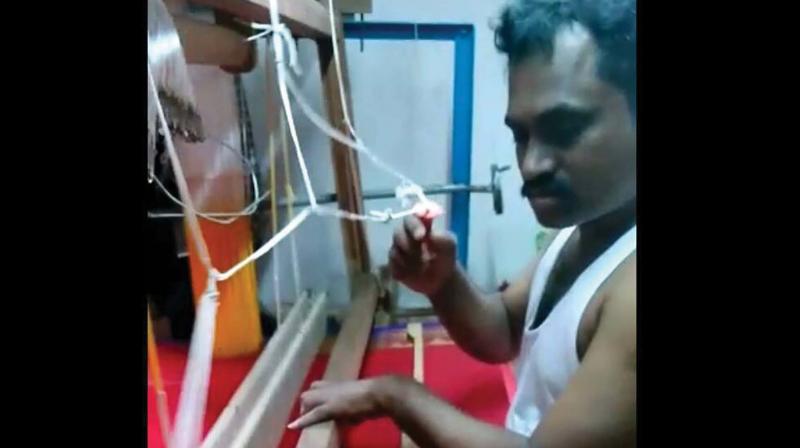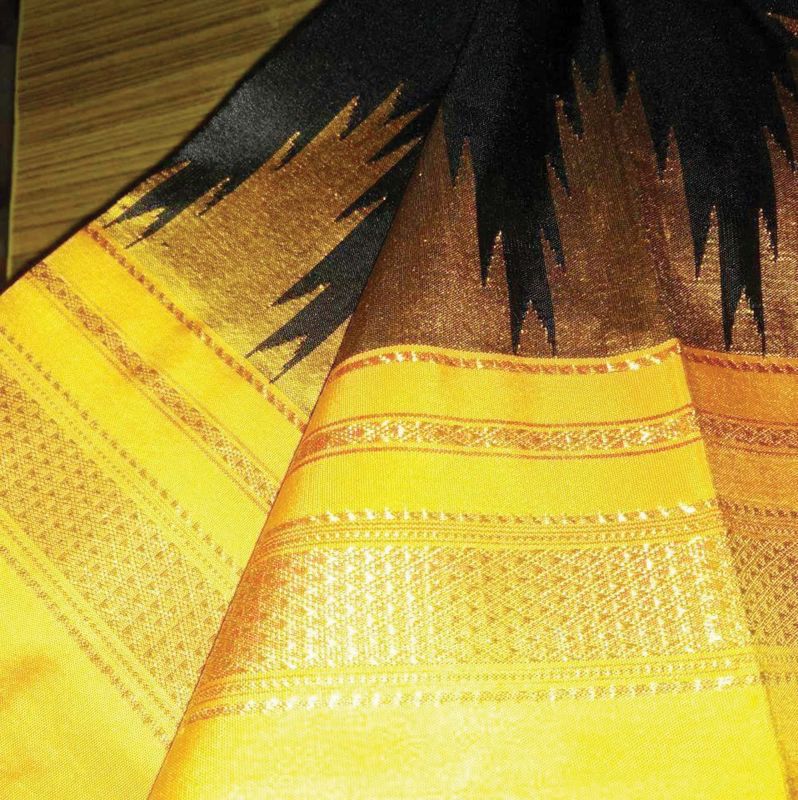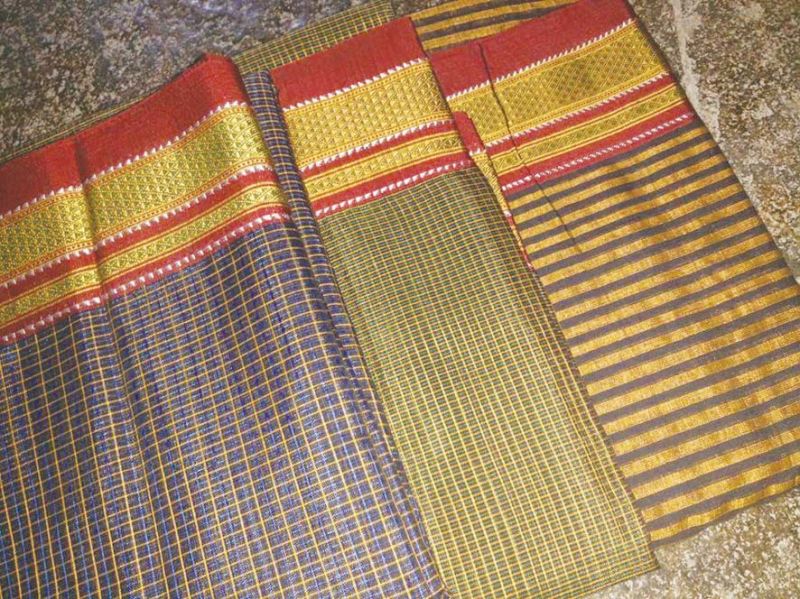When machines crush the charm of Ilkal sarees
Low-cost polyester sarees too are a potential threat to the Ilkal saree.

A 1,200-year-old weaving tradition is on the verge of extinction and no one seems to care! The Ilkal saree, first produced in the 8th century, continues to enthrall saree lovers all over the country and the world for its exquisite designs and intricate work which sets it in a class apart from other sarees. Painstakenly woven on the handloom by families in the little town of Ilkal in Bagalkote district, the hand-woven saree is slowly giving way to powerloom products with the machines able to roll out many more sarees in a jiffy.
Not that the saree is set to suddenly disappear from shop shelves. Even now, in every nook and corner of Ilkal, you can see families engaged in weaving the saree which has a huge customer base in Maharashtra, Andhra Pradesh and Karnataka. And what makes it so attractive to the saree lover? It’s the unique manner in which it is woven by joining the body warp and palu warp with a series of loops, called Tope Teni in local parlance.
It’s when marriages are round the corner that Ilkal sarees are more sought after as women in both the bride and groom’s families prefer to wear them till the rituals are completed. Initially, these sarees were used only by people in rural areas but now, Ilkal sarees are familiar to the urban population too.
A few years ago, as many as 25,000 people in the town toiled on the 5,000 odd handlooms to weave the Ilkal, which was their main source of revenue. These looms are now reduced to around 400 as the earnings from Ilkal weaving no longer suffice to meet a family’s expenses. Several people have migrated to big cities in search of jobs due to the high cost of weaving these sarees. Another deterrent is the rising cost of raw material including silk and cotton which has doubled in the last four years forcing them to bid adieu to their ancestral occupation.
“The new generation has lost patience and lacks the expertise needed to weave Ilkal sarees. Many of them work as daily wage labourers in the granite industry which has grown in leaps and bounds. The previous BJP government had conceived several programmes to promote Ilkal sarees but they were not implemented. A revolving fund should be set up by the government to provide a support price for the sarees and increase their marketability through wider publicity”, said Vijaykumar Guled, a fourth generation weaver.
And it‘s not only the withering interest of the younger generation which is to blame for the declining fortunes of the famed product. Powerlooms are being used everywhere to produce the sarees and the products are flooding the market leaving small handloom weavers helpless. Even the Geographical Indication (GI) tag for hand-woven sarees has not helped as powerlooms can produce 3-4 sarees every day while handloom weavers can hardly produce one in two days. The only consolation: Hand-woven sarees attract a price upto Rs 10,000 owing to their durability and unique design.
The plight of the Ilkal weaver has not gone unnoticed with social activists, writers and environmentalists opposing mechanization and introduction of power looms. They want the Handloom Reservation Act, that reserves 11 cloth products including Ilkal sarees exclusively for handlooms, to be strictly implemented. Leading this movement is writer and theater personality Prasanna, who founded ‘Charaka,’ a women’s co-operative society. But with most weavers shifting to powerlooms, this initiative has hardly had any impact.
“It’s pure economics at work, a powerloom costs more than Rs 1 lakh which the poor handloom weaver cannot afford. New generation weavers are opting for powerlooms hardly caring for the fact that they produce cheap and inferior quality Ilkal sarees”, said Ilkal Handloom and Powerloom Weavers Agitation Committee general secretary Ashok Shavi.
But the connoisseur still looks for the hand woven Ilkal and Internet marketing has helped weavers find markets via social media like whatsapp even in north India. Still, the weaver is disappointed over the appalling lack of support from those in power.
 A revolving fund should be set up by the government to provide a support price for the sarees and increase their marketability through wider publicity.
A revolving fund should be set up by the government to provide a support price for the sarees and increase their marketability through wider publicity.
“Earlier, textile department officials used to conduct raids if they found coloured clothes used to produce Ilkal sarees in powerlooms as it is reserved only for handloom as per the Act. We were allowed to use only white cloth in powerlooms. Now, there are no such restrictions and this poses a real threat to the the Ilkal saree”, said fifty-four year old weaver Ravindra Rayabagi who is a weaver since childhood.
Will the hand-woven Ilkal saree be pushed out of the market like many other products, remaining a distant memory for whose who cherish traditions? Will the machines overrun the town and its handloom weavers? That there are only a few hundred Ilkal weavers left is an agonising thought for women, who have worn the Ilkal and enjoyed its magically crafted designs and alluring charm for decades.
 Another deterrent is the rising cost of raw material including silk and cotton which has doubled in the last four years forcing them to bid adieu to their ancestral occupation.
Another deterrent is the rising cost of raw material including silk and cotton which has doubled in the last four years forcing them to bid adieu to their ancestral occupation.
‘We prefer death to running handlooms’
Sixty-three-year-old poverty-stricken Mehboobsab Chalagi has been weaving Ilkal sarees along with his wife for four decades like thousands of households in Ilkal town.
But things have now changed and the couple is struggling hard to bring up their seven children. The marriage of three daughters has left them in deep debt as the earnings from the two handlooms hardly suffices to have a square meal a day.
Wiser from years of experience, they deliberately preferred not to impart the Ilkal weaving technique to their children who have chosen other professions. The one saree the couple weaves every two days, is sold to the handloom weavers’ co-operative society that supplies cotton and silk to them.
They have to incur an expenditure of Rs 800 for raw material to produce one saree and sell it for Rs 1,000. It’s only in March, April and May-the marriage season-when they have work. Their four sons have dropped out of school and now work in auto garages or the construction industry as daily wage earners.
“The cost of silk has increased to Rs 5,500 per kg as against Rs 3,000 just four years ago. We cannot afford to buy powerlooms by spending lakhs of rupees. Sometimes I feel death is far better than running handlooms at this age”, rued Mehboobsab Chalagi.
Ilkal town has more than ten weavers’ co-operative societies which were established since 1950. Each society has around 1,000 members who enrolled over 6-7 decades. But 90 per cent of them have become inactive as they have stopped weaving the saree and have migrated to other cities in search of livelihood.
“The rich tradition of wearing these sarees is vanishing as the new generation is attracted towards western styled garments. Low-cost polyester sarees too are a potential threat to the Ilkal saree. I really feel that the government should do a lot more to safeguard the Ilkal tradition, which is the pride of North Karnataka”, said Gopal Pasalkar, secretary, Markandeya Weavers’ Co-operative Society.

